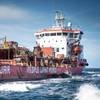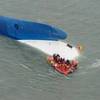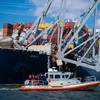UMass Hosts Atlantic Observation System Planners
The School for Marine Science and Technology of UMass Dartmouth hosted a consortium of 20 universities and organizations last week to plan the initial stages of a system to monitor the changing conditions and health of coastal waters from to . The consortium is developing a sophisticated network of weather stations, satellites, coastal radars and robotic underwater vehicles to produce a three-dimensional view of conditions in the coastal Mid-Atlantic. The current, three-year phase of the project is funded with an $8.7-million grant from the .
The Mid-Atlantic Regional Coastal Ocean Observing System, or MARCOOS, will provide decision-makers with information that will aid in search-and-rescue operations, hurricane track predictions, fisheries management, and the management of such emergencies as coastal flooding and pollutant spills. MARCOOS is one of eleven regional efforts comprising a national Integrated Ocean Observation System that NOAA is assembling.
Two scientists from the School for Marine Science and Technology have been awarded $1.36 million for their part of the project. SMAST Professors Wendell Brown and Avijit Gangopadhyay will operate a trio of coastal radars, and launch underwater glider surveys between and . They will incorporate the information provided by these devices into a computer model to help improve its forecasts.
SMAST will undertake underwater surveys in cooperation with , the leader of the consortium of research partners. has been fine-tuning gliders as ocean observers for the past decade. The glider of choice, built by Webb Research Corporation of , looks like a miniature jet airplane. It moves through the water by gulping in a mouthful (about 1 cup) of water at the surfacewhich causes it to sinkand spitting it out again when it reaches a predetermined depth. But rather than rising and sinking in place, it uses its wings, like a swooping bird, to convert vertical motion into forward motion, and thus glide its way through the ocean.
This propulsion scheme enables the glider to expend a minimum of energy while traveling great distancesoften hundreds of kilometers per mission. Its characteristic trajectory (like a roller coaster) and speed (less than one nautical mile per hour) are ideal for the glider’s task of collecting oceanographic data as it plumbs the upper water column.
















